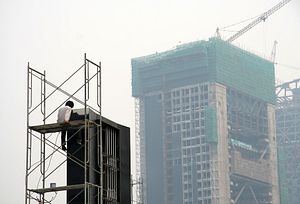When I first heard China was developing a bus that took up no road space and was partly solar-powered, I thought it was too good to be true. Then last May, China unveiled its “straddling bus,” with a ground clearance so high it could glide over traffic and a capacity equal to that of 40 standard buses.
But evidently the Transit Elevated Bus (TEB) only has a clearance of 2.1 meters, which is too low for some SUVs, trucks, and vans. Its other problems include being too tight, too high, too heavy, too expensive, having poor visibility, poor signaling—oh, and it may not be able to turn. Suddenly, the TEB was starting to resemble Ilya Zakharov’s Rio performance—a lot of hype followed by a bad flop. Then things got worse.
“Reports have emerged in the Chinese media,” wrote Will Coldwell of The Guardian, “suggesting that not only is the bus’s current manifestation completely unfeasible, but that TEB might even be some kind of elaborate Ponzi scheme.”
In a piece entitled “Is China’s super-bus a scam?,” Adam Minter pointed out that 200 investors already want out. And just like that, the TEB went from being a stroke of engineering genius to a useless rip-off.
About a week later, the BBC reported that the $3.4 million glass-bottom suspension bridge in Hunan province was being shut down for “urgent maintenance work,” less than two weeks after opening. Another flashy engineering feat gone sour.
This isn’t to denigrate Chinese engineering. After all, China is one of only three nations to put its own astronauts into space. It also boasts the world’s largest high-speed rail network with over 19,000 kilometers of track (although the technology was imported from France, Germany, and Japan). But engineering washouts like the TEB and the glass-bottom bridge remind us that China’s rapid development is often slapdash. What other countries have done in centuries, China is doing in decades, and it shows.
The Three Gorges Dam, for instance, the world’s largest hydroelectric dam, is also an environmental catastrophe. And the towns of Yujiapu, a replica of Manhattan outside Tianjin, and Tianducheng, a replica of Paris outside Shanghai, were shoddily smacked together and are now abandoned Potemkin villages. China fails at less flashy engineering projects, as well, such as bridges. There was the 2007 collapse of Hunan’s Tuo Bridge, a 328-meter stone construction that crumbled and killed 34 people when workers removed its scaffolding. Or the collapse of the Jiujang Bridge that same year. Or a bridge in Taiyuan. Or the Jintang Bridge in 2008. Or the Wuyishan Gongguan Bridge, Number 3 Qiantang Bridge, Baihe Bridge, and a bridge in Zigong, Sichuan—which all collapsed in July 2011. Or the Yangmingtan Bridge in 2012.
But it’s important to remember two things. First, these aren’t all engineering failures. The Taiyuan bridge, for example, was designed to hold 20 tons and buckled when a vehicle carrying 180 tons drove onto it. Second, this isn’t a uniquely Chinese problem. According to Wikipedia’s list of bridge failures, China has seen nine bridges collapse since 2000, while the United States has seen 20. But in so far as it is a Chinese problem, its causes are unique to China.
Writing for City Metric, Wade Shepard outlines seven reasons for China’s many engineering and workplace safety disasters, the most compelling being its rapid development and corruption. Shepard notes how, after the 2011 Wenzhou train crash, the problems with rapid development were laid bare, moving CCTV anchor Qiu Qiming to say, “China, please slow down. If you keep going so fast, you may leave the souls of your people behind.” And yet still the nation lurches, often blindly, forward.
Wuhan, the “city of a hundred lakes,” now has only 40, because in its race to modernize, many of them were filled in, and so now the city suffers serious flooding. But we cannot ask China to slow down, nor should it deign to listen. Besides, the real problem is that, as South China Morning Post noted in 2013, engineering and construction in China is a “hotbed of corruption.”
Of course, corruption in this area is punished. Just last December, police in Shenzhen arrested 11 after their negligent construction practices led to a landslide. But there simply isn’t enough being done to keep up with the ferocious pace of development and many incentives for corruption. If Beijing wants to keeps plowing ahead without things getting so bad the country starts circling the drain, then it’s either going to have to slow down or find a way to curb these incentives. Pulling back on state-run operations is one way to do that, but if the United States has shown China anything, it’s that Western corporatism is no better than Chinese communism.
































